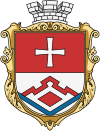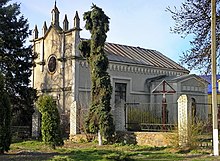Bershad
| Bershad | ||
| Бершадь | ||

|
|
|
| Basic data | ||
|---|---|---|
| Oblast : | Vinnytsia Oblast | |
| Rajon : | Bershad district | |
| Height : | 171 m | |
| Area : | 7.14 km² | |
| Residents : | 13,223 (January 1, 2011) | |
| Population density : | 1,852 inhabitants per km² | |
| Postcodes : | 24400 | |
| Area code : | +380 4352 | |
| Geographic location : | 48 ° 22 ' N , 29 ° 32' E | |
| KOATUU : | 520410100 | |
| Administrative structure : | 1 city | |
| Mayor : | Mychajlo Kolchenko | |
| Address: | вул. Радянська 15 24400 м. Бершадь |
|
| Website : | http://www.bershad.com.ua/ | |
| Statistical information | ||
|
|
||
Bershad (Ukrainian and Russian Бершадь ; Hebrew and Yiddish ברשד, Polish Berszad ) is a city in the Vinnytsia Oblast of Ukraine . It is located about 124 km southeast of the Oblast capital Vinnytsia on the Dochna River and is the administrative center of the Bershad Rajon of the same name .
The regional road P-54 and the territorial road T-02-02 run through the city . In the neighboring village of Floryne to the south there is a train station of the Hajworon narrow-gauge network .
history
The place was mentioned in writing for the first time in 1459 and initially belonged to Poland in the Bracław Voivodeship . At the end of the 18th century, it became one of the centers of Hasidic tradition and culture, the more than 200 year old synagogue of the shtetl is the world's oldest surviving clay synagogue. In 1795, as part of the third division of Poland-Lithuania , it became part of the Russian Empire and was administratively incorporated into the Podolia Governorate . The strong Jewish population increased in peacetime, but was repeatedly and bloody reduced by a series of pogroms , for the first time on a larger scale during the massacre of the Khmelnytsky uprising 1648–1657, and especially at the end of the 19th century by emigration to America again from.
During the Second World War , the place was occupied by Romanian and German troops and was given the Romanized name Berşad . The area conquered from the end of July 1941 was administered by the Romanian occupiers under the name of Transnistria . Before the outbreak of war, Bershad had between 4,000 and 5,000 Jewish residents. While marching into the city, the attackers killed around 10,000 Ukrainians and Jews. The remaining Jews were brought to a ghetto set up in a district on July 29, 1941 . The Bershad ghetto became the largest camp for Jews in Transnistria. It was filled with around 20,000 Jews deported from Bessarabia , who had walked for weeks from the Bessarabian intermediate camps (such as Mărculeşti , Edineț ) or train stations ( Otaci , Rezina, Bender ) before arriving . The ghetto consisted of twelve narrow streets of a Jewish quarter with 300 to 350 dilapidated adobe houses. About 60 people lived in each house. In autumn and winter, typhus spread in the Bershad ghetto and other ghettos in the region. When the epidemic broke out, a total of 24,000 to 25,000 Jews lived in Berschad. Of these, 16,000 Jews died in Bershad alone during and as a result of the typhus epidemic.
After 1944 Bershad came back to the Soviet Union and until 1966 the place only had the status of an urban-type settlement . Since independence in 1991, the city has been part of today's Ukraine .
literature
- Zvi Harry Likwornik: As a seven year old in the Holocaust - After the ghettos of Chernivtsi and Bérschad in Transnistria a new life in Israel 1934–1948–2012. 2nd, revised and expanded edition. Hartung-Gorre Verlag, Konstanz 2013, ISBN 978-3-86628-426-5 .
Web links
- Entry on the place in the geographical directory of the Kingdom of Poland and other Slavic countries
Individual evidence
- ↑ a b Entry in the Jewish Virtual Library
- ^ Bershad - Jewish legacy, dreizackreisen.de
- ^ Jean Ancel : The History of the Holocaust in Romania. (= The Comprehensive History of the Holocaust). University of Nebraska Press, Lincoln, and Yad Vashem, Jerusalem 2011, pp. 402-404.


